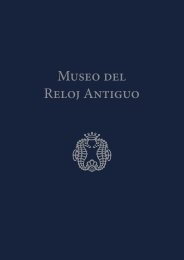You also want an ePaper? Increase the reach of your titles
YUMPU automatically turns print PDFs into web optimized ePapers that Google loves.
17. Reloj de sobremesa. Bronce dorado al mercurio y patinado. Base<br />
de mármol verde antico. De péndulo compensado. La esfera izquierda<br />
esmaltada con los signos del zodiaco y la derecha con hora universal.<br />
En las columnas, termómetro Réaumur y barómetro. En la parte superior,<br />
Higrómetro.<br />
Firmado, en los lados, por Lepaute/Horloger du Roi. Jean André Lepaute<br />
construyó la mayoría de los relojes de los edificios públicos de París,<br />
siendo el del Palacio de Luxemburgo el primer reloj horizontal que se vio<br />
en la ciudad.<br />
Francés. Imperio. Circa 1810. 68 x 56 x 18 cm<br />
Table clock. Patinated ormolu bronze. Marble verde antico base.<br />
Compensated pendulum. The left dial displays the signs of the zodiac in<br />
enamel and the right dial universal time. Réaumur Thermometer and<br />
barometer on the columns. Hygrometer in the upper part.<br />
Signed Le Paute/Horloger du Roi on the sides. Jean André Lepaute was a<br />
famous 18th-century French clockmaker. In 1753 he crafted the first<br />
horizontal clock in Paris for the Palais du Luxembourg. Most of the clocks<br />
in public buildings in Paris were made by Lepaute.<br />
French. Empire. Circa 1810. 26 ¾ in; 22 in; 7 in.




